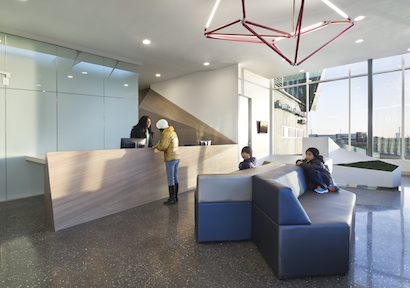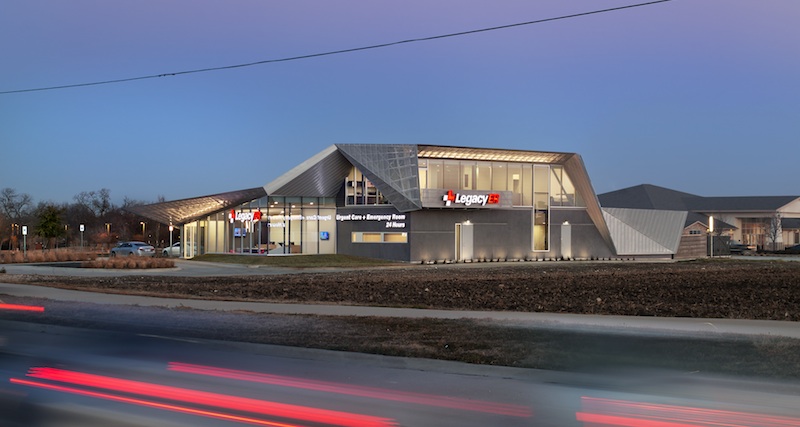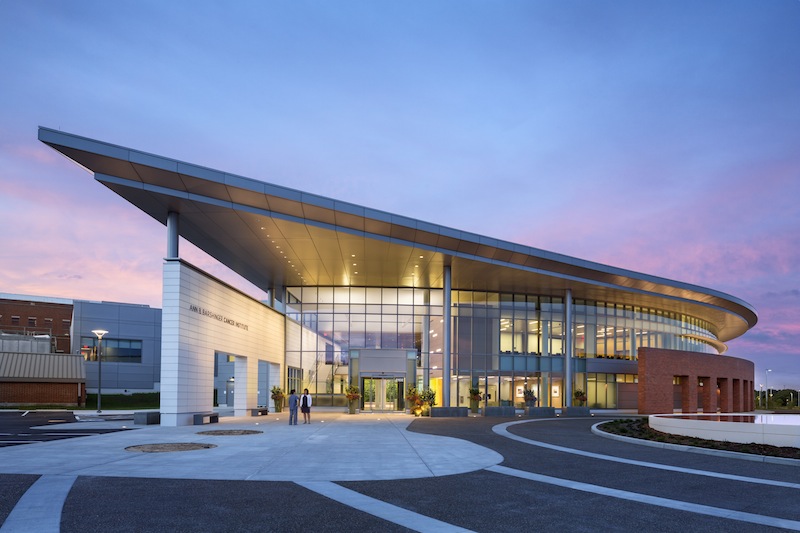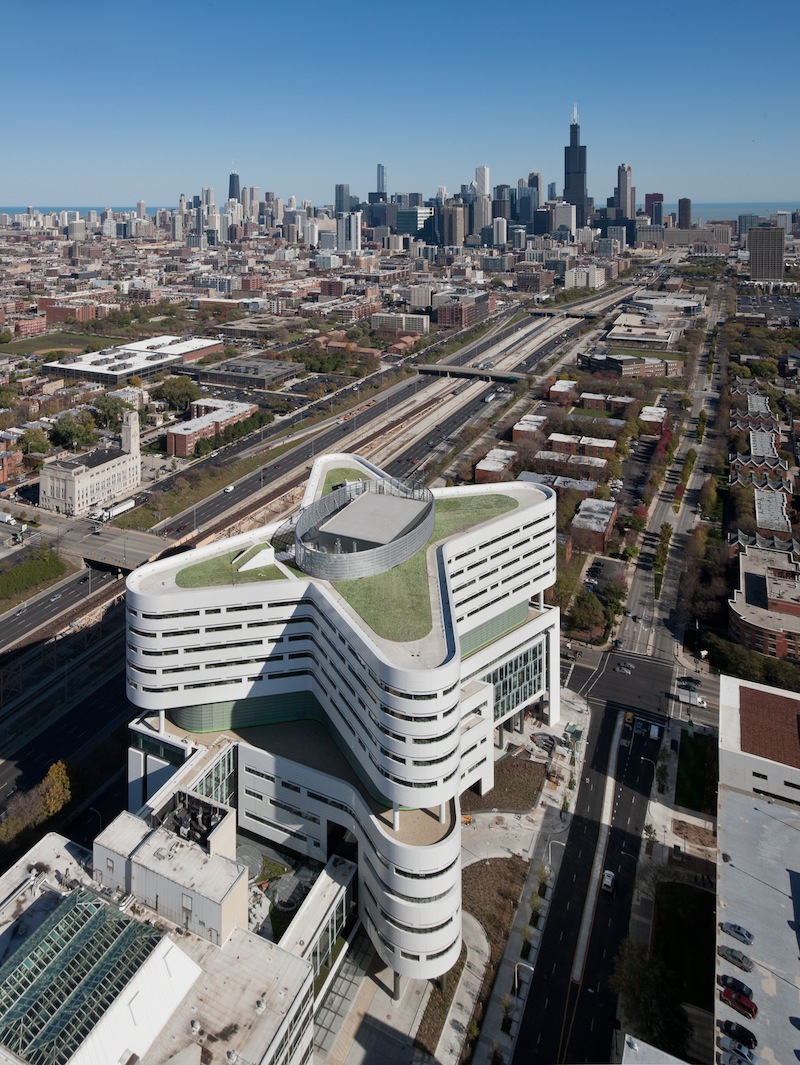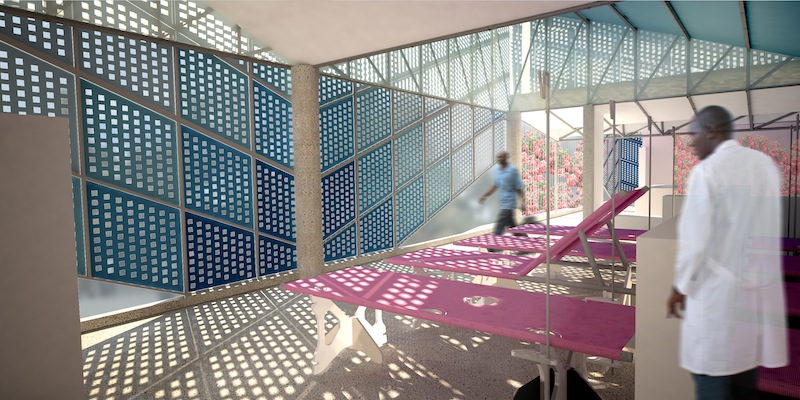The American Institute of Architects Academy of Architecture for Health has selected the recipients of the AIA National Healthcare Design Awards program. The AIA Healthcare Awards program showcases the best of healthcare building design and healthcare design-oriented research.
Projects exhibit conceptual strengths that solve aesthetic, civic, urban, and social concerns as well as the requisite functional and sustainability concerns of a hospital.
Recipients were selected in four different categories:
Category A: Built, Less than $25 million in construction cost
Category B: Built, More than $25 million in construction cost
Category C: Unbuilt, Must be commissioned for compensation by a client with the authority and intention to build
Category D: Innovations in Planning and Design Research, Built and Unbuilt
Jurors for the 2014 National Healthcare Design Awards include: Eric Goodfriend, AIA (Chair), Mahlum; Roger Call, AIA, Herman Miller for Healthcare; Jim Lennon, Lennon Associates; James C. Lord II, AIA, KGA Architecture; Mark Patterson, AIA, SmithGroupJJR; Mark Tortorich, FAIA, Stanford University and Shane Williams, AIA, Array Architects.
Category A
Legacy ER – Allen; Allen, Texas
5G Studio Collaborative
Legacy ER operates a hybrid program offering urgent and 24/7 state-licensed emergency care services within a freestanding building. Conceptualized as a potent reflection of the organization’s identity, the architecture captured the duality of the emergency medical professionals' character, projecting outwardly the knowledge, skill, precision, and decisiveness necessary for the competent practice of emergency medicine and expressing inwardly the gentle, empathic, and humanistic qualities of the persons beneath the robe, realized simply through montaging sharply folded exterior robe of zinc and softly sculpted interior plastered planes. Points of admission of natural daylight and views create apertures that elucidate intersecting tectonic moments.
Lightwell: Greater Boston Orthodontics; Waltham, Massachusetts
Merge Architects

Photo: John Horner Photography
A hundred-year-old storefront and warehouse on Main Street in Waltham was gutted, creating an open plan orthodontic clinic – including reception and treatment areas flanked by semi-private offices, toothbrushing stations, exam rooms, and a staff coffee area. The double-height treatment space is framed by an 18-foot-tall backlit translucent wall curving down in section to frame and light the open treatment area. CNC-cut plywood ribs skinned with thin polycarbonate panels funnel light from skylights above. The front waiting space is defined by a custom seating area and digital media bar, wool felt applied to walls, a custom light pendant, and bright custom wall graphics to provide wayfinding.
Category B
Lancaster General Health Ann B. Barshinger Cancer Institute; Lancaster, Pennsylvania
Ballinger
The new 100,000 square foot Ann B. Barshinger Cancer Institute is developed around a progressive model for cancer care and employs an interdisciplinary and patient-centric approach. Focused on regeneration and reconnection to living systems, the building’s radial form derives from an existing elevated, curvilinear arrival / parking court which has become a central courtyard healing garden. The expanded oncology program is arrayed around the garden on two levels. Glazed skins and multiple points of access provide a continuous dialogue between interior and exterior, creating a visually open environment that reduces anxiety and stress for patients and their families.
Mount Sinai Hess Center for Science and Medicine; New York City
Skidmore, Owings & Merrill LLP
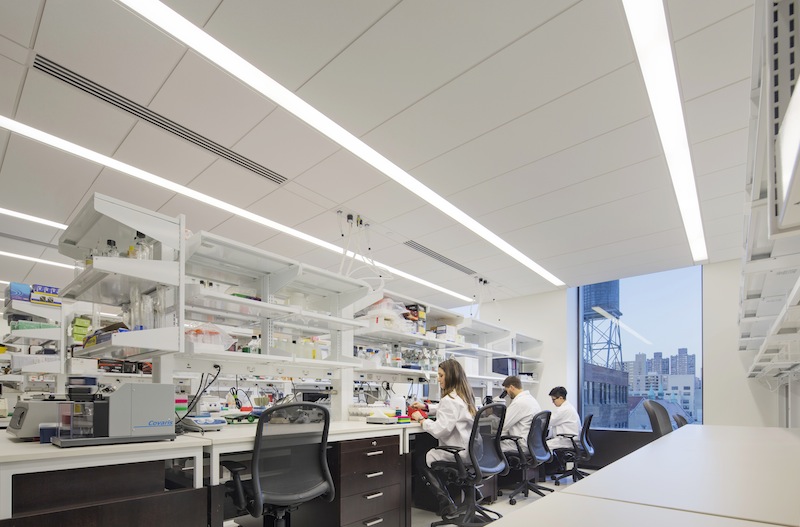
Photo © Eduard Huebrer / Archphoto
Envisioned as a place of discovery and healing, the striking Mount Sinai Hess Center for Science and Medicine is shaped by its translational research mission and urban context. Located in Upper Manhattan, the center places researchers, clinicians, educators, and patients in an integrated environment with state-of-the-art technology. The 420,000 square foot facility is specifically designed to foster multi-disciplinary interaction through a network of formal and informal settings. The primary design objective was to craft a flexible environment that would be inspiring and supportive for employees while gracious and dignified for patients and their families. Inside, natural light and a warm, simple material palette puts cancer patients at ease.
Rush University Medical Center New Hospital Tower; Chicago
Perkins+Will
As part of Rush University Medical Center’s 10-year, $1 billion Campus Transformation Project, Perkins+Will planned and designed a new 840,000 square foot state-of-the-art hospital building. Crowned by a butterfly-shaped bed tower designed to minimize steps between staff and patients, the new hospital is comprised of 304 acute and critical care beds, 72 neonatal intensive care beds, and 10 labor and delivery beds. The emergency department contains one of the country’s few bioterrorism preparedness facilities, and is designed to handle large-scale health emergencies. The hospital is one of the largest in the world to be certified LEED Gold.
Category C
Children’s Hospital of Richmond Pavilion (CHoRP); Richmond, Virginia
HKS, Inc.
At the gateway to the medical campus, the Children’s Hospital of Richmond Pavilion consolidates existing pediatric clinics into a compact vertical urban pavilion. The facility is dedicated to providing comprehensive healthcare for children and adolescents and contains a surgery level, three levels of pediatric clinics, a faculty/research floor, and seven levels of parking. Adjacent to some of the city’s most important civic structures, the design establishes a signature identity that embodies VCU’s objective of becoming the region’s premier pediatric academic medical institution. Drawing inspiration from natural elements that are unique to the City of Richmond, the design is intrinsically tied to its location. Themes of sky, water, and forest bring nature to the heart of this urban campus.
Category D
Cincinnati Children's Family Pet Center; Cincinnati, Ohio
GBBN Architects
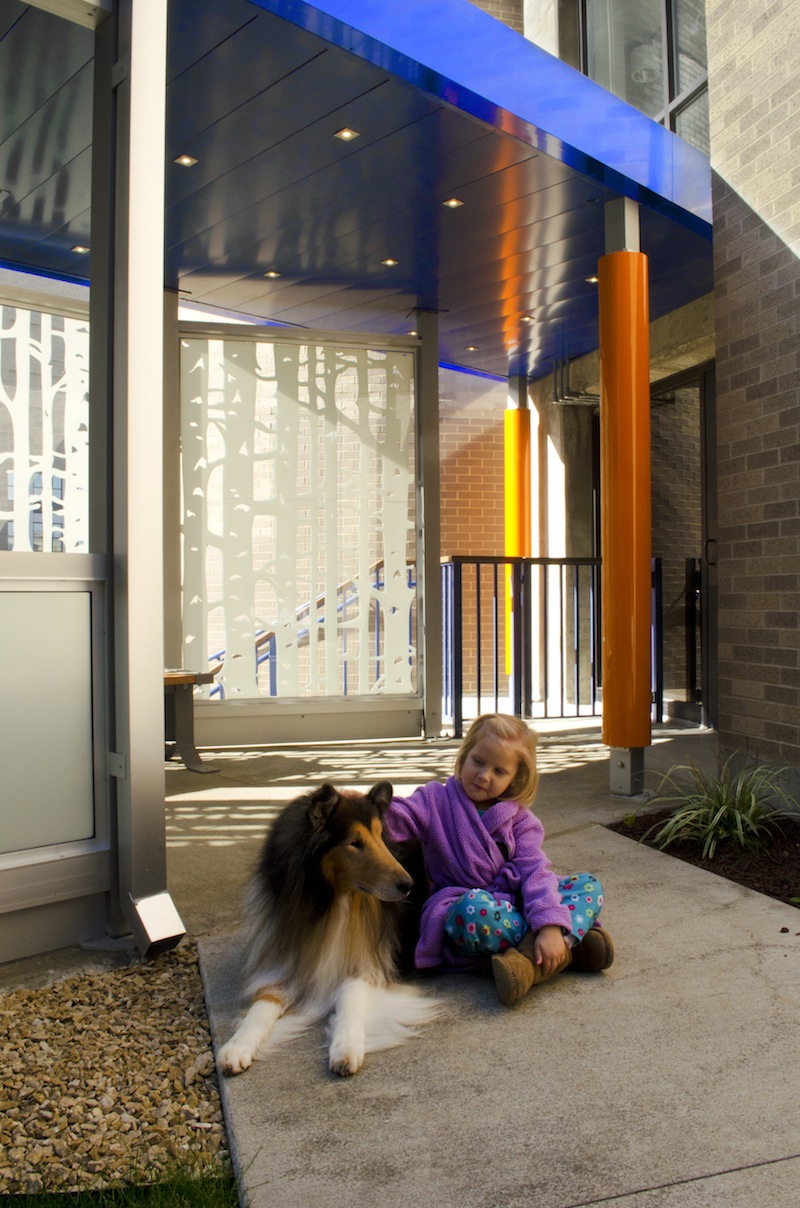
Courtesy Cincinnati Children's Hospital
The Family Pet Center expands the hospital’s pet therapy program with a 250-sf pavilion and lawn areas that accommodate patients whether on foot, in a wheelchair or on a stretcher. In this 8’ by 10’ enclosure, kids reunite with their own pets. Positive effects begin with anticipation days in advance, the visit itself, and the lingering effects of memories or storytelling afterwards. Based on research on the healing benefits of Animal Assisted Therapy (AAT), this pavilion addresses the medical needs of the children and the physical dynamics of pets. Especially for cancer patients, who deal with high levels of stress, pain, and long hospital stays, AAT contributes to recovery by improving the quality of life for patients.
GHESKIO Cholera Treatment Center (CTC); Port-au-Prince, Haiti
MASS Design Group
The first permanent facility in Port-au-Prince, the CTC provides an aggressive model for cholera treatment, while creating a healing space that promotes a dignified patient experience. Both the CTC’s layout and placement of amenities optimize staff and patient flow. The design tackles unique site conditions, including the lack of reliable piped water and lack of sewer system connection, by providing off-the-grid services. The roof collects rainwater, which is stored in cisterns, chlorinated, and then used for showers and sinks. The facility also decontaminates waste on-site and is designed to achieve 99.99% removal and inactivation of Cholera vibrio and other pathogenic organisms. The façade blends the use of the most advanced technology, using parametric modeling to optimize apertures for daylighting, ventilation, and privacy, with deploying analog techniques for local fabrication. The CTC will not only establish new standards for cholera treatment, but also new standards for quality construction in Haiti.
The video provides more information.
Building Better Builders from MASS Design Group on Vimeo.
Related Stories
| Feb 11, 2011
Grocery store anchors shopping center in Miami arts/entertainment district
18Biscayne is a 57,200-sf urban retail center being developed in downtown Miami by commercial real estate firm Stiles. Construction on the three-story center is being fast-tracked for completion in early 2012. The project is anchored by a 49,200-sf Publix market with bakery, pharmacy, and café with outdoor seating. An additional 8,000 sf of retail space will front Biscayne Boulevard. The complex is in close proximity to the Adrienne Arsht Center for the Performing Arts, the downtown Miami entertainment district, and the Omni neighborhood, one of the city’s fast-growing residential areas.
| Feb 11, 2011
Chicago architecture firm planning one of China’s tallest towers
Chicago-based Goettsch Partners was commissioned by developer Guangzhou R&F Properties Co. Ltd. to design a new 294,570-sm mixed-use tower in Tianjin, China. The Tianjin R&F Guangdong Tower will be located within the city’s newly planned business district, and at 439 meters it will be one of China’s tallest buildings. The massive complex will feature 134,900 sm of Class A office space, a 400-key, five-star hotel, 55 condominiums, and 8,550 sm of retail space. The architects are designing the tower with multi-story atriums and a high-performance curtain wall to bring daylight deep into the building, thereby creating deeper lease spans. The project is currently finishing design.
| Feb 11, 2011
Two projects seek to reinvigorate Los Angeles County medical center
HMC Architects designed two new buildings for the Los Angeles County Martin Luther King, Jr., Medical Center as part of a $360 million plan to reinvigorate the campus. The buildings include a 120-bed hospital, which involves renovation of an existing tower and several support buildings, and the construction of a new multi-service ambulatory care center. The new facilities will have large expanses of glass at all waiting and public areas for unobstructed views of downtown Los Angeles. A curved glass entrance canopy will unite the two buildings. When both projects are completed—the hospital in 2012 and the ambulatory care center in 2013—the campus will have added more than 460,000 sf of space. The hospital will seek LEED certification, while the ambulatory care center is targeting LEED Silver.
| Feb 11, 2011
Sustainable community center to serve Angelinos in need
Harbor Interfaith Services, a nonprofit serving the homeless and working poor in the Harbor Area and South Bay communities of Los Angeles, engaged Withee Malcolm Architects to design a new 15,000-sf family resource center. The architects, who are working pro bono for the initial phase, created a family-centered design that consolidates all programs into a single building. The new three-story space will house a resource center, food pantry, nursery and pre-school, and administrative offices, plus indoor and outdoor play spaces and underground parking. The building’s scale and setbacks will help it blend with its residential neighbors, while its low-flow fixtures, low-VOC and recycled materials, and energy-efficient mechanical equipment and appliances will help it earn LEED certification.
| Feb 11, 2011
Texas megachurch inspired by yesteryear’s materials, today’s design vocabulary
The third phase of The First Baptist Church of Pasadena, Texas, involves construction of a new 115,000-sf worship center addition. Currently in design by Zeigler Cooper, the project will include a 2,500-seat worship center (with circular layout and space for a 50-person orchestra and 200-person choir), a 500-seat chapel (for weddings, funerals, and special events), and a prayer room. The addition will connect to the existing church and create a Christian Commons for education, administration, music, and fellowship. The church asked for a modern design that uses traditional materials, such as stone, brick, and stained glass. Construction is scheduled to begin this summer.
| Feb 11, 2011
Apartment complex caters to University of Minnesota students
Twin Cities firm Elness Swenson Graham Architects designed the new Stadium Village Flats, in the University of Minnesota’s East Bank Campus, with students in mind. The $30 million, six-story residential/retail complex will include 120 furnished apartments with fitness rooms and lounges on each floor. More than 5,000 sf of first-floor retail space and two levels of below-ground parking will complete the complex. Opus AE Group Inc., based in Minneapolis, will provide structural engineering services.
| Feb 11, 2011
Four-story library at Salem State will hold half a million—get this—books!
Salem State University in Massachusetts broke ground on a new library and learning center in December. The new four-story library will include instructional labs, group study rooms, and a testing center. The modern, 124,000-sf design by Boston-based Shepley Bulfinch includes space for 500,000 books and study space for up to a thousand students. Sustainable features include geothermal heating and cooling, rainwater harvesting, and low-flow plumbing fixtures.
| Feb 11, 2011
Green design, white snow at Egyptian desert retail complex
The Mall of Egypt will be a 135,000-sm retail and entertainment complex in Cairo’s modern 6th of October district. The two-story center is divided into three themed zones—The City, which is arranged as a series of streets lined with retail and public spaces; The Desert Valley, which contains upscale department stores, international retailers, and a central courtyard for music and other cultural events; and The Crystal, which will include leisure and entertainment venues, including a cinema and indoor snow park. RTKL is designing the massive complex to LEED Silver standards.
| Feb 10, 2011
7 Things to Know About Impact Glazing and Fire-rated Glass
Back-to-basics answers to seven common questions about impact glazing and fire-rated glass.
| Feb 10, 2011
Medical Data Center Sets High Bar for BIM Design Team
The construction of a new data center becomes a test case for BIM’s ability to enhance project delivery across an entire medical campus.


